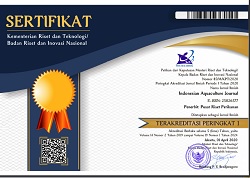FEED EFFICIENCY AND GROWTH OF CATFISH (Clarias sp.) FED WITH THE ADDITION OF IMMUNE-BOOSTING FERMENTED EARTHWORMS
Abstract
Keywords
Full Text:
PDFReferences
AOAC. (2005). Official Methods of Analysis (18 Ed.). Association of Official Analytical Chemist Inc. Mayland. USA.
Boaru, A., Struti, D., Daraban, S.V., & Bogdan, G. (2016). The Effect of Using Earthworm Meal (Eisenia foetida) as Protein Supplement for the Growth of Xhiphophorus hellerii Juveniles. Poeciliid Research, 6(1), 4-9.
Djissou, A. S. M., Adjahouinou, D.C. koshio, S.& Fiogbe, E.D. (2016). Complete replacement of fish meal by other animal protein sources on growth performance of Clarias gariepinus fingerlings. Springer Int Aquat Res., (2016) 8, 333–341. DOI 10.1007/s40071-016-0146-x
FAO. (2016). Fisheries and Aquaculture Departemen. Global aquaculture production species (Clarias gariepinus). Rome.
Halver, J.E., & Hardy, R.W. (2002). Fish nutrition. Academic Press. Amsterdam. 824 p.
Istiqomah, L., Sofyan, A., Damayanti, E. & Julendra, H. (2009). Amino Acid Profile of Earthworm and Earthworm Meal (Lumbricus rubellus) for Animal Feedstuff. J. Indonesian Trop., 4,253-257. DOI: 10.14710/jitaa.34.4.253-257.
Kawamoto, M.S., de Souza, G.B., & Nogueira, A.R.A. (2019). Preparation and Evalution of a New Reference Material for Macro- and Micro Nutrients in Fish Feed. Microchemical Journal,. 149,1-9.
Lourdumary, A.J.B. & Uma, K. (2013). Nutritional Evaluation of Earthworm Powder (Lampito mauritii). Journal of Applied Pharmaceutical Science, 3(3), 82-84.
Maryam, S., Hastuti, S., & Rahmawati, D. (2019). Effect of eartworms (Lumbricus sp.) silage as fish meal substitution in artificial feed on feed utilization and growth of tambaqui (Colossoma macropomum). Jurnal Sains Akuakultur Tropis, 3(1), 61-69.
Mohanta, K.N., Subramanian. S & Korikanthimath, V.S. (2016). Potential of earthworm (Eisenia foetida) as dietary protein source for rohu (Labeo rohita) advanced fry. Cogent Food & Agriculture, 2,1-13. 1138594.
Musyoka, S.N., Liti, D.M., Ogello, E., & Waidbacher, H. (2019). Utilization of the earthworm, Eisenia fetida (Savigny, 1826) as an alternative protein source in fish feeds processing: A review. Aquaculture Research, 50(9), 2301-2315.
NRC (National Research Council). (1983). Nutrient requirement of warm water fish and shellfish. Revised Edition. National Academy of Sciences. Washington D.C. 102p.
Nugraha, T.A., Isnansetyo, A., Triyanto & Djalil, M. (2022) Fermented earthworms as a feed additive enhances non‑specific immune response in catfish (Clarias gariepinus). Aquaculture International, 30, 211–226.
Olele, N.F. (2011). Growth response of Heteroclarias fingerlings fed on earthworm meal in hatchery tanks. Journal of Life Science, 3(2), 131-136.
Sanjukta, S., & Kumar R.A. (2016). Production of bioactive peptides during soybean fermentation and their potential health benefits. Trends in Food Science & Technology, 50,1-10.
Taris, M.R., Limin, S. & Harpeni, E. (2018). Effect of substitution of fish meal with earthworm meal (Lumbricus sp.) on the growth of giant tiger shrimp (Penaeus monodon). e-Jurnal Rekayasa dan Teknologi Budidaya Perairan, 6(2), 699-704.
Vital, V.D.S.J., Diane, N.S.K., Apollinaire, M.G. & Didier, F.E. (2016). Culture of earthworm (Eisenia fetida), production, nutritive value and utilization of its meal in diet for Parachanna obscura fingerlings reared in captivity. International Journal of Fisheries and Aquatic Studies, 4(5), 1-5.
Zakaria, Z., Salleh,N.H.M., Mohamed, A.R., Anas, N.G.A. & Idris, S.N.A. (2012). Optimization of Protein Content in Earthworm-based Fish Feed Formulation for Catfish (Clariaus gariepinus). Sains Malaysiana, 41(9), 1071–1077.
Zonneveld, N., Huisman, E.A. & Boon, J.H. (1991). Principles of aquaculture. Gramedia Pustaka, Jakarta, 318 p
DOI: http://dx.doi.org/10.15578/iaj.17.2.2022.157-163

This work is licensed under a Creative Commons Attribution-ShareAlike 4.0 International License.

Indonesian Aquaculture Journal is licensed under a Creative Commons Attribution-ShareAlike 4.0 International License.
















_25.jpg)


